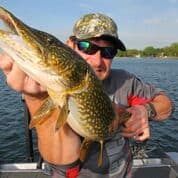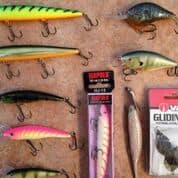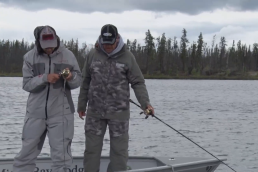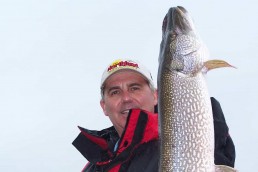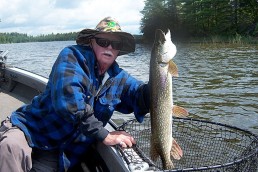Twin Cities Pike Tactics for June
SHARE THIS POST
Now that summer fishing season is in full swing, anglers have their choice of species to target when they hit the water on Minnesota lakes. In the Twin Cities metro and surrounding suburbs, we are blessed with dozens of quality fisheries where a variety of species can be caught. You can access good fishing from shore, and numerous lakes have public fishing docks installed that extend your cast toward deeper water and a chance at bigger specimens patrolling the drop-offs just offshore.
The popularity of kayak fishing is exploding, and with good reason. You can rig a portable boat or canoe with accessories and carry your craft to the water’s edge to roam far and wide in the lake of your choice. And with public boat launches on virtually every lake, you can tow your motorized craft to enjoy the same freedoms.
While panfish can be caught from most any lake—finding and catching walleyes consistently on metro waters is a practiced art—the gamefish species most readily available to anglers here are largemouth bass and northern pike. Prolific and easy to catch, a day of casting for these two popular choices makes for a fun day.
In last month’s issue, we talked about how important water temperature is in regard to a northern pike’s location in a given lake. In June, with surface temps pushing into the 70s, finding and catching the biggest pike in a system becomes more challenging. Intolerant of water temps above 60 degrees, adult pike push into deeper water either to roam the basin below the thermocline or to hold along deep weed edges. Only juvenile pike will be in the shallows. To catch the big fish, you have to focus your efforts in deeper water.
While casting the shallows in May produces big fish, trolling tends to rule the day in warm-water conditions. Contour trolling, which involves positioning lures to run specific edges and controlling the boat in kind, is an easy tactic to employ with today’s advanced electronics and mapping systems. Select lures that dive deep, and experiment with size, profile and color to see what triggers the most bites. Don’t be frustrated when you occasionally hook submergent vegetation; simply adjust your depth by trolling slightly deeper or by changing lures to stay just above/outside of the weed edge.
Are you enjoying this post?
You can be among the first to get the latest info on where to go, what to use and how to use it!
Although zebra mussels are an unwanted invasive species, a side benefit of their introduction into metro lakes is that water clarity has improved dramatically. In turn, on some lakes the weedlines are migrating deeper due to improved light penetration. The closer this cover pushes toward summer thermoclines, the more pike are potentially holding along deep weedlines. To increase your odds, seek out vegetation adjacent to rocky structure. The combination of weeds and rocks—especially rock structures adjacent to deep water—is a home-run location for summertime northerns.
One more benefit of improved water clarity in lakes is that casting jerkbaits and deep-diving crankbaits around key structure and deep weed edges can be productive. Pike are sight-feeders, and will aggressively pursue forage suspended above them in the water column, so for a change of pace from trolling weedlines, don’t hesitate to make some casts. Choose lures that permit a long cast and a long, deep retrieve, and don’t hesitate to make casts that parallel a given weedline and run perpendicular to the structure. Some big fish will suspend and hold well away from the edge of the weeds, and an open-water cast can produce surprising results. When casting, focus on weed and rock structures and zones where previous trolling passes have been most productive.
Arsenal of lures for June pike:
- Large-profile, minnow-style twitch baits, like number 12 and 14 Husky Jerks, especially in vibrant colors, UV color patterns and lures with plenty of orange, yellow and white that imitate predominant forage like sunfish, bluegills and perch. These lures will pause and suspend on the troll during “S-turns” and also are ideal for casting along deep weedlines and submerged rock reefs surrounded by deeper water.
- Trolling lures, such as number 9 Scatter Rap Tail Dancers. These lures that run 11 to 18 feet on the troll, depending on line diameter and trolling speed, excel at wobbling the weed edge and enticing strikes. Typically, the bigger-profile lures will minimize strikes from pesky hammer-handle pike.
- Deep-running, fat-bodied crankbaits, such as Rapala DTs and number 7 Scatter Rap Cranks, especially in colors that imitate small sunfish and bluegills. Unfortunately, the number 7 Crank is not yet available in the “Deep” Series—the current 5 is a bit small for pike and tends to get inhaled by bigger specimens. The DT Series, however, are perfect lures to try because the larger bill on the deep-diving models helps keep the lure on the outside of a pike’s jaws.
4. VMC Gliding Jigs. Get yourself some of the Oklahoma-style blades, featuring an enticing, wobbling, slow-fall tumble. Rig up a variety of bulky soft plastics to see what happens. The action of this new lure introduction can’t be described; it has to be seen. This offering tumbles and slow-falls down the edge of a weedline into the depths where the big critters live.
MWO
SHARE THIS POST
Did you enjoy this post?
You can be among the first to get the latest info on where to go, what to use and how to use it!
